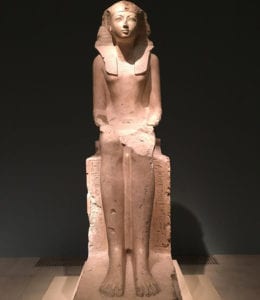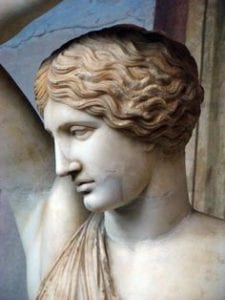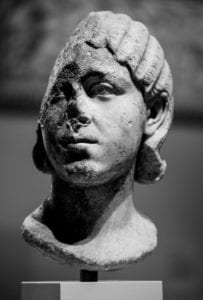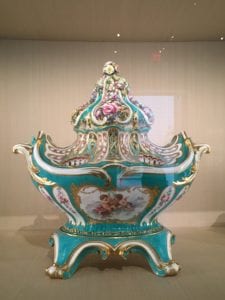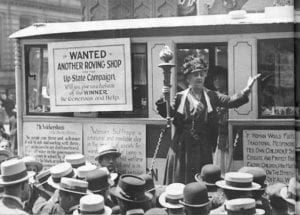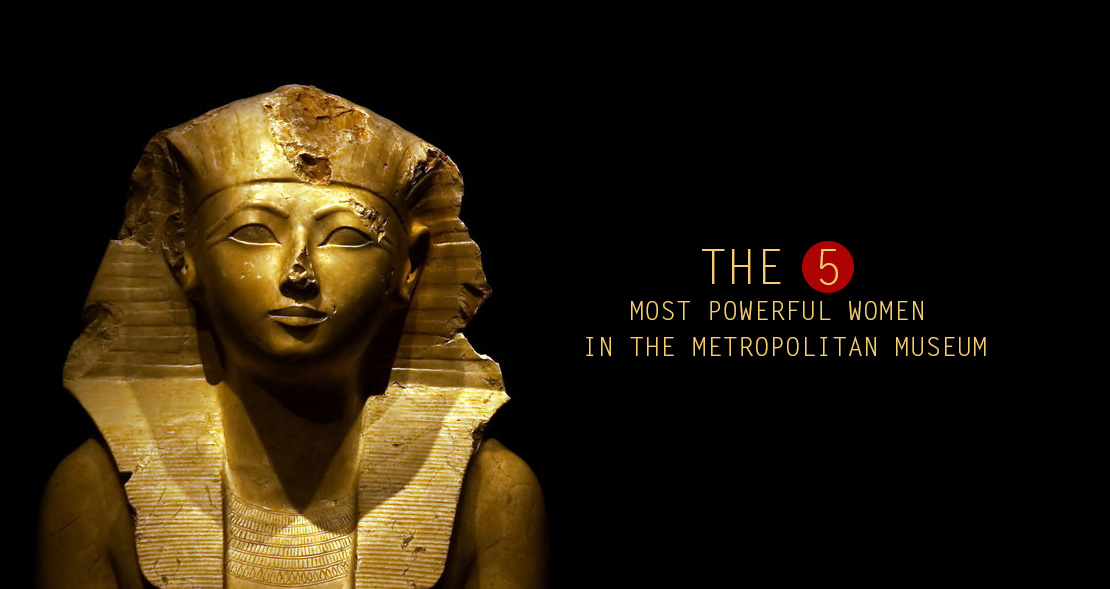
21 Mar The Five Most Powerful Women in the Metropolitan Museum
My esteemed colleague Mary Beard has posted an article about the five most powerful women in the British Museum, as a celebration of Women’s History Month. So since we are now doing a tour about that topic at the Metropolitan Museum, I thought I should answer with a post about the most powerful women in the Met. Because the Met actually has a lot of powerful women, from the most powerful woman pharaoh of ancient Egypt through women of the 20th century. And this year of all years, now is the time for some women’s history!
1. Pharaoh Hatshepsut
Any discussion of powerful women at the Met must start with Pharaoh Hatshepsut, who reigned from 1479-1458 BC—because the Met has an entire gallery of statues of her. Hatshepsut was a daughter of Pharaoh Thutmose I and the principal wife of Pharaoh Thutmose II. When her husband died, his son (by a minor wife) Thutmose III was only two years old, and Hatshepsut reigned in his place as regent. She never however handed the kingdom over to him. Instead, while theoretically always co-regent, she in effect ruled Egypt as Pharaoh until her death 21 years later. She was an enormously important pharaoh: among other things, she established the trading relations that underlay the prosperity of the New Kingdom, and she was the first pharaoh to build a mortuary temple in the Valley of the Kings. At some point in Thutmose III’s reign her statuary was all defaced or smashed, and most references to her were excised from inscriptions. For a long time, scholars believed that this was due to her Thutmose III’s resentment of her. In fact, however, he was her principal general, and it seems unlikely that he resented her, because he could have revolted against her had he wanted to. The defacements also seem to have taken place late in his reign and may instead relate to dynastic issues connected to his son’s succession. In any case, the Met has many statues of Hatshepsut. She always wears the regalia of a pharaoh, parts of which—such as the false beard—imply that she is male. In some cases, however, such as the one pictured here, the sculptor balances her pharaonic regalia with female elements of her physiognomy (such as facial structure) to make an image of a woman pharaoh.
2. Mythological Amazon
There are various Ancient Greek images that also, I think, belong in this category, because although the Greeks (and particularly the Athenians, who created so much of the art in museums) confined at least elite women to something like purdah and deprived them of almost all roles in public life, yet they were strikingly aware of women’s potential power, as revealed by the many female beings in their mythology, from powerful goddesses such as Demeter and Athena (generally portrayed with a helmet, shield, and spear!) to bugaboos such as the gorgons or the Amazons. The Amazons were a mythological race of women fighters, and many of the heroes of Greek mythology fought against them: Heracles, Theseus, and Achilles, for instance. Modern scholars believe that the idea of female fighters derived from nomadic peoples on the plains of Eastern Europe, such as the Scythians, who fought with bow and arrow from horseback, and among whom both men and women could be fighters. Rumors of this must have reached the Greeks, and given how shocking women fighters must have seemed to them, they invented on that basis a race exclusively of women fighters, equal—or almost equal—to the greatest heroes. The Met’s statue, in which blood seeps from a wound in the Amazon’s side but she faces her death with serenity, fits well with Greek ideals of heroism and reminds us that the Greeks repressed women—but were frightened of them as well.
3. Empress Julia
Roman women were considerably freer than Greek women, and the women of the Imperial families exercised (as far as we can tell) much more political power than Greek elite women did. This was particularly true in the Severan dynasty, a dynasty which ruled over the Empire from 193 to 235 AD, which was dominated by a series of matriarchs. The last of these was Julia Avita Mamaea, mother of Emperor Severus Alexander. Like Hatshepsut, Julia Mamaea ruled as regent for her son at the beginning of his reign, and while she did cede power to him when he came of age, she seems to have remained remarkably powerful afterwards as well. She accompanied the Emperor on his military campaigns and was the first woman ever named consors imperii, “partner in rule,” or Empress. Also, she was assassinated with the Emperor. In another parallel to Hatshepsut, Mamaea was subjected to damnatio memoriae—the destruction of her name and images. It is uncertain whether the bust in the Metropolitan was damaged at that time or in subsequent centuries.
4. Royal Mistress Madame de Pompadour
What about modern powerful women? There are of course many representations of queens, but I think it is more interesting to think about another sort of powerful woman who is very present in the collection but largely forgotten today: royal mistresses. In particular, the most famous of all royal mistresses, Louis XV’s mistress Madame de Pompadour, is an important theme in the museum: the museum has a famous bust of her, at least one painting commissioned by her, and several objects that belonged to her, including a mechanical table and this elaborate Sèvres potpourri vase. The vase reminds us of Madame de Pompadour’s importance as a patron of artists and craftsmen. Today this might sound like an unimportant “feminine” role, but the patronage of women like Madame de Pomadour was instrumental in establishing France as a production center for luxury good—which it remains today. You might, I believe, see this as a kind of industrial policy, and the Sèvres porcelain factories were a perfect example: they were established to compete with Meissen ware, just as the Meissen factories were established to compete with Chinese imports, because all European countries in the 17th and 18th centuries had large trade deficits with China. So Madame de Pompadour was not just shopping: she was establishing France as a manufacturing center in order to reduce the national deficit. This was typical of royal mistresses, but Madame de Pompadour also had a good deal of political power: she controlled access to the king and also served as his principal advisor for a period in the 1750s when he ruled without a prime minister.
5. Suffragette Louisine Havemeyer
Finally, I want to mention one woman you won’t see on the walls (although there is a famous Mary Cassatt portrait of her). Instead, you see paintings that she donated on the walls. This is Louisine Havemeyer, wife of the sugar king, Horace Havemeyer. Louisine was great friends with Mary Cassatt, who introduced her to the then latest trends in French painting, and she purchased many canvasses by Courbet, Manet, and Degas, a number of which she ended up donating to the museum. But she was not only into recent artistic trends, she was also, like Cassatt, a well-known example of what was then called “the new woman.” And she was, like many powerful women over time, well aware of the limits on her agency and anxious to achieve liberation not only for herself but others. As a result, she co-founded the National Women’s Party, one of the key forces pushing for the 19th amendment. She spent a great deal of time making speeches, writing articles, and engaging in protest: for instance, she tried to burn President Wilson in effigy in front of the White House. I am attaching a picture of her making a speech with a torch in her hand that she often carried on marches in imitation of the Statue of Liberty. Louisine Havemeyer was in fact not only a powerful woman, she was also a great role model: generous, public-spirited, articulate, and above all, feisty. She is, I think, a great person to remember in Women’s History Month—so come on our Nasty Women tour, and learn more about her and other feisty, powerful women!




